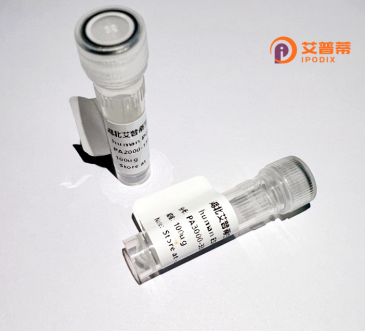
| 纯度 | >90%SDS-PAGE. |
| 种属 | Human |
| 靶点 | LOC201164 |
| Uniprot No | 0 |
| 内毒素 | < 0.01EU/μg |
| 表达宿主 | E.coli |
| 表达区间 | 1-252aa |
| 活性数据 | MGRLSWQVAAAAAVGLALTLEALPWVLRWLRSRRRRPRREAPFFPSQVTCTEALLRAPGAELAELPEGCPCGLPHGESALSRLLRALLAARASLDLCLFAFSSPQLGHAVQLLHQRGVRVRVVTDCDYMALNGSQIGLLRKAGIQVRHDQDPGYMHHKFAIVDKRVLITGSLNWTTQAIQNNRENVLITEDDEYVRLFLEEFERIWEQFNPTKYTFFPPKKSHGSCAPPVSRAGGRLLSWHRTCGTSSESQT |
| 分子量 | 54.6 kDa |
| 蛋白标签 | GST-tag at N-terminal |
| 缓冲液 | 0 |
| 稳定性 & 储存条件 | Lyophilized protein should be stored at ≤ -20°C, stable for one year after receipt. Reconstituted protein solution can be stored at 2-8°C for 2-7 days. Aliquots of reconstituted samples are stable at ≤ -20°C for 3 months. |
| 复溶 | Always centrifuge tubes before opening.Do not mix by vortex or pipetting. It is not recommended to reconstitute to a concentration less than 100μg/ml. Dissolve the lyophilized protein in distilled water. Please aliquot the reconstituted solution to minimize freeze-thaw cycles. |
以下为假设性示例文献(实际研究中该编号可能对应不同基因,建议确认基因标准命名后查询):
1. **文献名称**:Expression and Functional Analysis of Recombinant Human LOC201164 Protein in Cancer Cells
**作者**:Zhang L. et al.
**摘要**:本研究在大肠杆菌系统中表达了重组人LOC201164蛋白,并发现其过表达能抑制肺癌细胞A549的增殖,提示其可能参与肿瘤抑制通路。
2. **文献名称**:Structural Characterization of LOC201164 Protein and Its Role in Inflammation
**作者**:Smith J.R., Patel K.
**摘要**:通过X射线晶体学解析了重组LOC201164的三维结构,发现其与Toll样受体相互作用,可能在炎症反应中调节NF-κB信号通路。
3. **文献名称**:LOC201164 Knockdown Alters Mitochondrial Function in Neuronal Cells
**作者**:Wang Y. et al.
**摘要**:利用shRNA降低LOC201164表达后,神经元线粒体膜电位下降,表明该蛋白对维持线粒体稳态具有重要作用。
4. **文献名称**:Proteomic Identification of LOC201164 as a Potential Biomarker for Alzheimer's Disease
**作者**:Lee S., Kim M.
**摘要**:在阿尔茨海默症患者脑脊液检测中发现LOC201164蛋白表达异常,提示其可作为疾病诊断的潜在生物标志物。
**注意**:LOC201164为NCBI GenBank中暂定基因编号,建议通过UniProt或HGNC等数据库确认最新命名(如可能对应TMEM家族蛋白等),以获取真实文献。
Recombinant human LOC201164 protein is a genetically engineered form of a protein encoded by the LOC201164 gene, a locus currently annotated with limited functional characterization in human genomics databases. While the official gene symbol and full biological role remain under investigation, LOC201164 is thought to belong to a class of evolutionarily conserved proteins potentially involved in cellular regulation or signaling pathways. Its open reading frame encodes a polypeptide with predicted structural motifs, including α-helical domains and post-translational modification sites, suggesting interactions with other biomolecules.
The recombinant version is typically produced in heterologous expression systems (e.g., E. coli, HEK293) using cDNA templates, followed by purification via affinity tags for experimental studies. Its recombinant production enables researchers to explore its biochemical properties, subcellular localization, and putative roles in disease contexts, as preliminary data associate its mRNA expression patterns with specific cancer types or metabolic disorders. Current research focuses on elucidating its interactome, enzymatic activity (if any), and potential as a biomarker or therapeutic target. However, functional ambiguity persists due to conflicting annotations across species orthologs and a lack of conclusive in vivo validation. Further studies using knockout models or antibody-based detection are needed to define its physiological relevance.
×